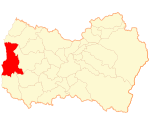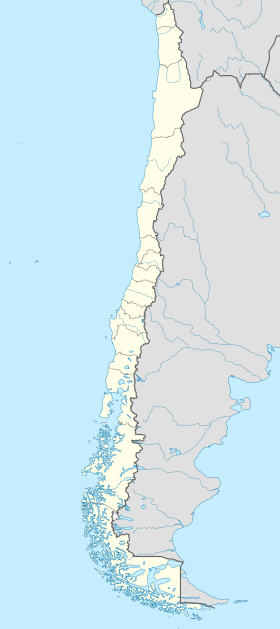
Back Pichilemu Afrikaans Pichilemu AN Picilemo ANG بتشيلمو Arabic بيتشيليمو ARZ Piychillimu Aymara Piçilemu Azerbaijani Пичилему Bashkir Пічылему Byelorussian Пичилему Bulgarian
Pichilemu | |
|---|---|
 The Pichilemu city hall, as seen in April 2011 | |
|
| |
| Nickname: Surf Capital (Capital del Surf) | |
 Location of the Pichilemu commune in O'Higgins Region | |
| Coordinates: 34°23′31″S 72°00′50″W / 34.39194°S 72.01389°W | |
| Country | |
| Region | O'Higgins |
| Province | Cardenal Caro |
| Settled | 24 January 1544[1] |
| Commune created | 22 December 1891 |
| Government | |
| • Mayor | Cristian Pozo Parraguez (2021-2024) |
| • City Council | Councilors |
| Area | |
| • Total | 749.1 km2 (289.2 sq mi) |
| Elevation | 27 m (89 ft) |
| Population (2012 census)[2] | |
| • Total | 13,916 |
| • Density | 19/km2 (48/sq mi) |
| Demonym | Pichilemino |
| Time zone | UTC-4 (Chile Time (CLT)[3]) |
| • Summer (DST) | UTC-3 (Chile Summer Time (CLST)[4]) |
| ZIP codes | 3220478 |
| Area code | (+56) 72 |
| Website | www |
Pichilemu (Mapudungun: Small forest, pronounced [pitʃiˈlemu] ⓘ), originally known as Pichilemo,[5] is a beach resort city and commune in central Chile, and capital of Cardenal Caro Province in the O'Higgins Region. The commune comprises an urban centre and twenty-two villages, including Ciruelos, Cáhuil, and Cardonal de Panilonco. It is located southwest of Santiago. Pichilemu had over 13,000 residents as of 2012.
The Pichilemu area was long populated by the indigenous Promaucaes. European-Chilean development began in the mid-sixteenth century, as conquistador Pedro de Valdivia gave Juan Gómez de Almagro the Topocalma encomienda (which included the current territory of Pichilemu) in January 1541. Pichilemu was established as a subdelegation on 16 August 1867, and later as an "autonomous commune" on 22 December 1891, by decree of the President Jorge Montt and Interior Minister Manuel José Irarrázabal. Agustín Ross Edwards, a Chilean politician and member of the Ross Edwards family, planned to develop it as a beach resort on the Pacific Ocean for upper-class Chileans.
Pichilemu is home to five of the National Monuments of Chile: Agustín Ross Cultural Centre and Park; the wooden railway station, Estación Pichilemu; El Árbol tunnel; and the Caballo de Agua. Part of the city was declared a Zona Típica ("Traditional Area" or "Heritage Site") by the National Monuments Council, in 2004.
The city is part of District No. 16 and is in the senatorial constituency of O'Higgins Region electoral division. Pichilemu is home to the main beach in O'Higgins Region. It is a tourist destination for surfing, windsurfing and funboarding.
Tourism is the main industry of the city, but forestry and handicrafts are also important. Pichilemu has many expansive dark sand beaches. Several surf championships take place in the city each year at Punta de Lobos.
- ^ Cite error: The named reference
Restos indígenaswas invoked but never defined (see the help page). - ^ Codigo 6201, Pichilemu, Comisión Externa Revisora del Censo 2012 (August 2013). "Anexo 1. Población Reportada a Nivel Comunal" (PDF). Al Informe Final: Anexos (in Spanish). National Statistics Institute (INE). p. 41. Archived from the original (PDF) on 3 December 2014.
{{cite web}}: CS1 maint: numeric names: authors list (link) - ^ "Chile Time". World-Time-Zones.org. Archived from the original on 11 September 2007. Retrieved 5 May 2007.
- ^ "Chile Summer Time". World-Time-Zones.org. Archived from the original on 11 September 2007. Retrieved 5 May 2007.
- ^ Astaburuaga Cienfuegos, Francisco, ed. (1899). . Diccionario Geográfico de la República de Chile (Geographic Dictionary of the Republic of Chile) (in Spanish).
© MMXXIII Rich X Search. We shall prevail. All rights reserved. Rich X Search



